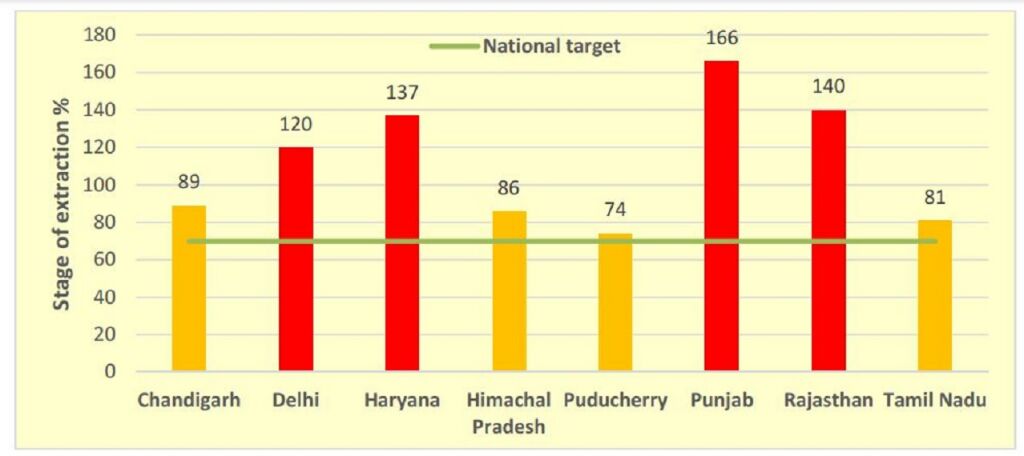A glaring gap
CAG report has found the groundwater management and regulation by CGWA to be deficient — requiring extensive capacity building

The Comptroller and Auditor General of India (CAG) conducted the performance audit of groundwater management and regulation to analyse the extent of groundwater scarcity in the country.
The audit report was presented in the Parliament on December 21, 2021. The audit was conducted on the basis of five years of data (2013-2018) on groundwater management and regulation in India.
The main objectives of the CAG audit were to ascertain the implementation of groundwater regulations, mechanism for managing groundwater, targets and objectives on the schemes of groundwater management and appropriate steps taken to achieve the relevant targets under the United Nations-mandated Sustainable Development Goal 6 that addresses water scarcity among other issues.
"As much as 77 per cent units in 18 states of India are operating without no-objection certificates (NOC) despite clear instructions in the consent to operate (CtO) document," according to the report.
As on March 31, 2019, 10,578 fresh applications and 144 for renewal were pending with the Board, the report stated. "The quantum of pending NOCs was three times more than the fresh NOCs issued last year."
Among units granted license by the Bureau of Indian Standards (BIS) in 15 states of India, 78 per cent were extracting groundwater without NOC, according to the findings.
It is clear that there is no connection between the licenses granted by BIS and the obtaining of NOC from the Central Ground Water Authority (CGWA) and such instances shall continue in future as well, if not stopped today.
Sustainable development goal
There is a major threat in achieving SDG goal 6 as the CAG report reveals the bitter truth of groundwater management in India. Despite CGWA guidelines and CGW board (CGWB), the implementation and management of policies is extremely weak and needs scaffolding to strengthen it.
To increase water-use efficiency under SDG target 6.4, the NITI Aayog has indentured one indicator which is 'percentage of groundwater availability against net annual availability'. The national target value for this indicator is 70.
Report highlights that over the period from 2004 to 2017, there has been a severe downturn in assessment units which are categorised as safe (<70 per cent), whereas the percentage of blocks categorised as semi-critical, critical and over-exploited has increased.
In fact, the overall stage of groundwater extraction has increased from 58 per cent in 2004 to 63 per cent in 2017, which is a matter of great concern.
According to the CAG report, there are eight states or Union territories in the country, which have values higher than the target of 70.
Expert's point of view
"All the states shall adopt model groundwater bill and try to regulate their own groundwater. States like Uttar Pradesh, Haryana and Punjab have already implemented this," said a groundwater expert from CGWA.
CGWA shall work for advisory and policy making, whereas work related to NOC, inspections and others shall be done by respective state departments, he added.
The authority does not have adequate staff for managing hundreds of thousands of industries, the expert pointed out. "Respective state departments shall strengthen them and they shall monitor it."
Conclusion
It can be clearly seen that the activities of CGWA are not in coherence with the targets and indicators set by NITI Aayog's 'Transforming our world for achievement of Sustainable Development Goals'. Majority of packaged drinking water units are running without valid NOC.
Eight states have clearly violated the national level targets of groundwater extraction and the condition of NOC has also been breached in many states.
A clear and vivid picture of mismanagement can be seen in terms of issuing NOC for groundwater withdrawal and aquifer mapping. There is a vacuum created by CGWB in order to implement the regulations.
The observations made by the CAG report are realistic and depicts the deficiencies in the management of groundwater and regulation by CGWA. Still, there are weak groundwater regulations prevailing in the country and there is an urgent need to strengthen them so that SDG goal 6 can be achieved.
A lot has to be done for achieving SDG 6 by 2030. With the current scenario and implementation of groundwater management and regulations, it seems unrealistic and irrational.
This lack of capacity and public advocacy hurts implementation of the provisions on groundwater management and regulations. Enormous capacity building is required for the successful rollout of the regulations.
Way forward
⁕ There is an urgent need of strong mechanism for management of groundwater in India so that regulations are effectively and efficiently implemented
⁕ Proper tracking systems or audit activities are required from time to time on the schemes of groundwater management and regulation so that true picture is available
⁕ CGWB strictly needs to take adequate steps to strengthen its organisation by increasing its manpower and taking advice from experts so that the country can achieve the SDG 6 target by year 2030
⁕ CAG needs to assess from time to time, the progress made by CGWB so that India can fulfil its commitment towards SDG goal 6
⁕ CGWB needs to review its progress and shall plan its interventions soon at state as well as at central-level to bridge the gap. DTE
Views expressed are personal



